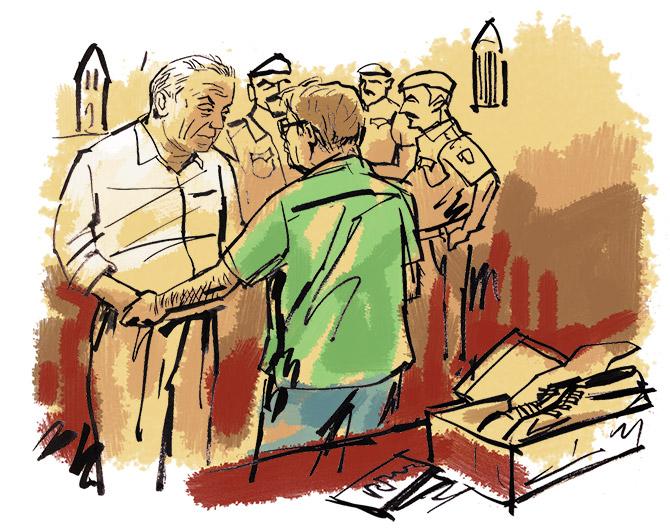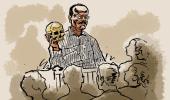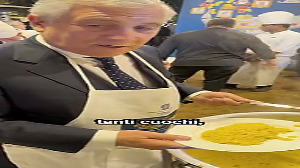It will be his fifth birthday in jail as an undertrial. He was arrested two days before his birthday in 2015.
Tuesday also marked Peter's fourth year in jail.
Vaihayasi Pande Daniel reports from the Sheena Bora murder trial.
Illustration: Dominic Xavier/Rediff.com

"Sun liya baba," Peter Mukerjea tiredly told the difficult guard, who was badgering him, as he picked up the bag the police had been unceremoniously rifling through, and headed back to the Arthur Road jail, central Mumbai.
His younger brother Gautam had come to see him all the way from Goa, in court, after a long interval, as a little pre-birthday surprise, bringing him shoes, a T-shirt, pastries, chocolate and fruits.
These gifts were exchanged post the Tuesday, November 19, 2019 hearing in the Sheena Bora murder trial, outside Courtroom 51 at the Mumbai city civil and sessions court, a landmark of Kala Ghoda, south Mumbai, which most cabbies have never heard of.
Peter had requested for an extra 15 minutes from the judge to spend with his brother and permission to take the gifts.
The time was granted.
But not the shoes. Rules did not permit accepting a gift of shoes because in the past prisoners had smuggled other items into jail via shoes.
CBI Special Judge Jayendra Chandrasen Jagdale was a little short with Peter's lawyers for not alerting him (Peter) to that.
But instead of giving Peter 15 minutes, the main and more senior uniformed police guard began aggressively pestering Peter to leave after hardly a few minutes.
The chocolate, without an explanation, was flatly not permitted. And returned to Gautam. Maybe chocolate is considered too big a luxury for undertrials.
Peter is turning 64 on November 21.
It will be his fifth birthday in jail as an undertrial. He was arrested two days before his birthday in 2015. Tuesday also marked Peter's fourth year in jail.
Countless valuable lessons about life and human beings can be realised from courtrooms, trials and observing the fate, particularly, of undertrials.
Like how situations may arise in life where one has to arm one's self with ceaseless, calming, patience, just to face each new morning.
Like about the twists life might take, whereby never-ending hope and faith is all one has to live by, well, because there is nothing else to sustain one's self with.
Like how courts reduce a person to the least common denominator. Never mind who they were earlier, now they are as good as guilty and just a statistic, a number, virtually no one in our system.
Like the amount of luck and 'what ifs' that actually run our life, with impunity.
Like the vast amounts of sheer fortitude one must possess to face the oddest and most sudden misfortunes life might spring on you.
It is amazing to view undertrials, of all sections of the population, at the sessions court, and notice how, maybe due to the peculiarly sturdy Indian variety of tolerance and capacity to adjustment, they finally adapt themselves to this hideous fate and are still able to smile. The undertrials you see don't radiate the pent-up anger and frustration you would expect them to.
Every smile an undertrial, be he guilty or mostly be he not, is able to offer, needs to be applauded because only he knows the courage it takes to pull up that smile.
And because would you have the courage to smile faced with the same circumstances?
In the immensely puzzling Sheena Bora trial there are actually umpteen 'what ifs' that rule the narrative.
What if the Mukerjeas had never come back to India from Bristol, following which they were arrested?
What if Indrani Mukerjea's former husband Sanjeev Khanna had not come to Mumbai to meet his daughter Vidhie?
What if Sanjeev's cousin had been there the day he attempted to meet Vidhie in Mumbai?
What if driver Shyamvar Pinturam Rai never came to work for the Mukerjeas?
What if Indrani's children from her first marriage, Sheena and Mekhail Bora, had not tracked down their biological mother?
What if Indrani had not hidden the fact she had two other children?
What if she hadn't divorced her first husband and never met Sanjeev or Peter?
What if love has not blossomed between Sheena and Rahul Mukerjea, Peter's son from an earlier marriage?
What if the police had never apparently been tipped off in 2015 about the alleged murder?
Had any of these 'what ifs' become a reality would we even be here today covering this trial?
Tuesday brought Prosecution Witness No 59 Shrikant Hanumant Lade, a resident of Tara Rani Chowk, Kolhapur, to the box. (Trial coverage, incidentally also exposes one also to a vast selection of humanity.) Once the assistant director at the Forensic Medical Laboratory at Kalina, north west Mumbai, Lade in 2015 conducted the DNA tests on the various remains, said to be Sheena's, recovered by the police, from a site in Raigad district, where her corpse was allegedly part burnt and later buried.
Lade was as different from his immediate predecessor in the witness box as chalk is from cheese.
If Dr Shailesh Mohite, forensic expert from the B Y L Nair hospital central Mumbai, the witness before Lade, had been clear, precise and was a distinctive and authoritative presence, Lade by contrast mumbled, ate up all his words, as if he was snacking on them, like they were crunchy bhel puri and wore a vaguely hang-dog look. He hardly cracked a smile.
There was something intense about him, as if he was being troubled deeply by an issue. That intensity was not evident in the way he spoke. Nor did it match the mildly sloppy, insipid and starchless manner in which he gave his testimony in chief for this trial, which lasted two hours, till 1.45 pm.
In his 50s, studious-looking in thick black-framed spectacles, Lade was dressed in a white, checked graph shirt, black pants and grey sports shoes. A chunky silver watch glinted off his left wrist and his fingers were bare of rings.
Lade earned his MSc in biochemistry from Shivaji University, Kolhapur, and had an additional postgraduate degree in DNA fingerprinting. He had been working at Kalina till 2016 after which he became the assistant director at the Regional Forensic Sciences Laboratory, Kolhapur.
During his nine years of work in Mumbai, Lade said he had analysed approximately 2,500 to 3,000 specimens of DNA, including cases related to Mumbai's 26/11 terror attack, the Shakti Mills rape and the INS Sindhu Rakshak submarine explosion.
That works out to the flabbergasting rate of more than one DNA test a day, apart from numerous court appearances, and proved him to be an extremely hard-working specialist. A 2015 report about Lade in the Indian Express had him speaking about an increased work load after his lab had to start testing confiscated cow's meat.
Lade's DNA evidence relating to the Sheena Bora case was critical.
It was for the first time in court, historically, as a young colleague crucially pointed out to me, that the prosecution was presenting what could be termed unimpeachable scientific evidence that connected Indrani Mukerjea's DNA to the motley and sad bunch of human remains dug out from a random pit near a Raigad village named Gagode Khurd.
So one more secret confirmed, among an orderly, dark and deep cupboard full of secrets Indrani has been discovered to own, like additional husbands and offspring who were not siblings.
Prosecutor Manoj Chaladan, the third and slightly taciturn prosecutor on this trial, started Lade's testimony off by asking him to, he emphasised, "briefly" recount how DNA was identified from a sample of human remains.
Lade's "brief" and un-crisp recounting went on for ten or 15 tortuous minutes, as one was hard pressed to decipher the account of his methods. That it involved nearly 16 or more hours of work, a gram of bone powder, benzyl chloride, incubation, ice baths, a deep freeze, multiple bouts of centrifuging, several rounds of "vortexing" was about all one picked up, but one wasn't any nearer to knowing, for purely general knowledge purposes, the process.
Chaladan's purpose in having Lade recount the process and later explain the various methods he opted for -- like the PCR technique and the STR method, chosen for their "discriminatory power" -- was purely a pre-emptive strategy.
He was expecting the defence -- to be more accurate white-coated Doctors Shrikant Shivade and Sudeep Ratnamberdutt Pasbola -- having marshalled themselves with a new-found arsenal of DNA-printing facts, to question Lade extensively during the cross-examination on why he did what he did scientifically. And Chaladan was conducting a dry run with the morose Lade.
The scientist then ran through the paperwork for the various specimens he had received from the forensic department of the Nair hospital and Khar police station, north west Mumbai, who handled the murder investigation in 2015 till the CBI took it over later that year.
There were bones from the Gagode Khurd site like both the femurs of the legs, the lower cervical vertebrae of the back. There were teeth. Blood samples of Mekhail Bora, Indrani Mukerjea and Shyamvar Rai. Three pairs of shoes. A pair of "ear tops". Earth samples. A suitcase.
Of all this material, the most crucial turned out to be one of the femur bones because as Lade referred to the reports his DNA fingerprinting tests had generated, he told the court: "I analysed the DNA profile obtained from the blood samples of Indrani Mukerjea and Shyamvar Rai. In my opinion I found that Indrani Pratim Mukerjea is concluded to be the biological mother of the DNA of the left femur bone."
At the end of his testimony he, rather strangely and awkwardly, however, corrected himself. He said he made a mistake reading his own reports and that when he had said left femur bone he meant the right femur. It was recorded that "witness volunteers that he has wrongly mentioned left femur bone instead of the right femur bone."
Reading yet another report, referred to as D-12 Lade declared, "The DNA profile of the lower cervical vertebrae matches the DNA profile obtained from the blood sample of Indrani Mukerjea. I have analysed these two DNA profiles and then I opined that Indrani Mukerjea is concluded to be the biological mother of the cervical vertebrae bones."
Lade's bland recital of his deductions, that clearly and unmistakeably connected Indrani to the DNA evidence obtained from the bunch of bones, hair and teeth found in far-off rural Raigad, didn't seem to bother or rouse Indrani much. Or elicit any of her characteristic exaggerated responses from her usually bulging bag of eloquent expressions and mime.
Sitting at the back of the courtroom in the accused box, next to a now heavily-bearded Sanjeev, she looked her usual perky self in a white kurta matched with a red bandhni chunni, her hair, with a side parting, demurely pulled back in a bun.
According to a recent Mumbai Mirror report, Indrani spends her allotted Rs 4,000 in jail purchasing among other things makeup, bindis, hair dye because she always 'dresses up' in 'colourful kurtas' and 'applies cosmetics' to come to court.
The other four conclusions Lade's DNA testing threw up were that:
A. From the blood samples he had been sent he was able to conclude that Mekhail's biological mother was Indrani.
B. The material like the soil samples, shoes, had not produced any "amplifiable" DNA.
C. Rai's DNA did not match up to anything from the site.
D. Significantly the teeth and other femur bone had yielded "no interpretable DNA profile". These belonged to the batch of samples from the first exhumation and postmortem that was conducted by local doctor Sanjay Thakur. It was organised by the Pen police station, the nearest police station to Gagode Khurd, when a random corpse was discovered in May 2012 and then was oddly forgotten about for three years after that.
Dr Mohite in his testimony had also already stated that the bones from the first exhumation did not match the bones from the second exhumation. Lade in his statement inadvertently underlined Dr Mohite's conclusion further.
Towards the end of his testimony Lade was required to identify the bones from which he had extracted the DNA.
The lady court clerk duo, like they ran a mini in-house mortuary, for now the third or fourth time, rummaged about among their extensive and scary bone collection to produce a few yellow-brown bones.
Out came two femurs. And a handful of vertebrae.
Lade gingerly examined them, pointing out the FSL pen marking on the bone.One of the lawyers remarked to his colleague, "Chuna nahin chahiye (They should not touch them)."
And then poor Sheena's bones were once again packed away into covers, till their next viewing.
What happens to discarded bones from a concluded murder trial? Are they taken to the Chandanwadi crematorium, south Mumbai, and burnt? Or maybe buried somewhere? Where is the graveyard of court bones?
When will these bones be finally put to rest?
That's a question we all would like to have the answer to! The Sheena Bora trial once again looks like it will not be wrapped up any time soon.
One lawyerly estimate put it at: "Another two years." Whew!
Lade's cross examination will begin November 27 when certain documents the defence required, are obtained like the electropherograms (showing DNA sequencing) and the DNA database.
No doubt on November 27 Pasbola will display to us that he is India's great wizard on electropherograms.
As the accused and lawyers departed, all looked at the new cubicle that has suddenly come up on the third floor landing (and other landings). Most of the landing had been boxed up to form a brand-new rickety cubicle, blocking off light and ventilation which is already in dreadful short supply in these quarters.
No one knew what this fresh cubicle was for. One of the lawyers joked, given the severe shortage of space in this court: "Just watch, after a few days you will see a judge seated inside!"










